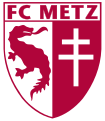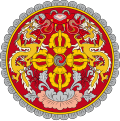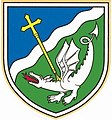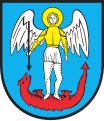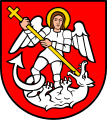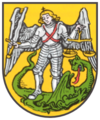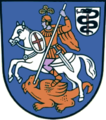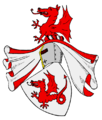Dragon (heraldic animal)
The mythical beast dragon is an emblem of heraldry .
presentation

The dragon is a mean figure . His performance is provided by a large pointed head at a reptile-like body, which is often green tinged is. Other colors are possible, but black is the second dominant color.
The representation of the dragon is varied and follows local traditions: It is mostly fire-breathing from its nostrils and has spiky wings, which are thin-skinned (bat-like). All reinforcements , i.e. tongue, claws, comb, and often the wings are usually shown in a pungent tincture to the rest of the body.
The dragon with a worm-shaped abdomen, also called wyvern in English heraldry , is referred to in many depictions as a lindworm . The differences are clear to the heraldist - despite the similar representation that occurs, as always in heraldry it is decisive whether the mythical animal is emblazoned as a 'dragon' or 'lindworm' (described in words), not like a heraldist would has shown. The demarcation to the panther , an eagle-clawed lion with an often dragon-like head, is also clear. The hydra , the nine-headed dragon, is just as independent .
History and use
Its entry into heraldry is attributed to the Crusaders . In heraldry, it is usually only used with one head. In mythology , he is usually represented with one head in the west and with several heads in the east, as is customary in China , the presumed country of origin. It is a good luck charm in East Asia. In Conrad Grüneberg's book of arms from 1483 a fantasy coat of arms of the first Kaisser Jullius is depicted.
The heraldic animal was also the namesake for the Hungarian Dragon Order . This was donated in 1418 as an order of knights .
In the Asian region, the dragon has found its place on coats of arms and flags under the name Asian or Chinese dragon . Here it is always shown in full.
Variants of the kite
Positions
Wales - striding, four feet
Trutnov - lying
Bhutan (flag) - floating backwards
FC Metz - looking backwards
Bad Goisern - armed and resisting
Roetgen - inclined to the left and pierced by a golden cross lance
Wachtberg - with his tail crossed
Modified representations
Blaibach , - with a spiky tail and a golden clapper
Skiptvet , NO - Lindworm with a prickly tail
Wormsdorf , - with a tangled tail in mixed up colors
Wörth an der Lafnitz , AT - Wolfsdrache
Tarascon , FR - six-legged dragon
Kyakhta , RU - dragon head with fish comb
Kozje (Drachenburg), SI - dragon with a long tail wound around a tower
Bhutan - typical Asian dragon, bearded, horned, feathered, scaled
In Auerbach (Deggendorf district) the armed dragon hovers over a mountain of three. In the Osnabrück district there are various coats of arms with the Artländer dragon . The coat of arms of the von Kesselstatt family should also be noted .
George with the kite
In many heraldic fields he is depicted fighting with St. George . The dragon is his attribute . In the vast majority of cases, St. George is on a horse and pierces the dragon with a lance .
See also: Georg (saint) #Heraldik
Michael and the dragon
The fight of the Archangel Michael with Satan is usually represented as a fight against a dragon, as in the Revelation of John .
The difference to the dragon slayer Georg in heraldry is easily recognizable: Michael always has spread wings. He usually wears light armor and is shown walking. His weapon is the flame sword , but also a lance , alternatively a cross . Often St. Michael stands on the dragon after he has knocked it down. As Michael's second attribute that comes scales before, this refers to its function as a soul Geleiter the Last Judgment .
Aizarnazabal , ES
Dolsk , PL - with lance
Buttstädt - with sword and scales
Forchtenberg - with the cross spear
Ludwigshafen- Maudach - with flaming sword and scales
Zeitz with sword
Roman warrior and the dragon
The coat of arms of Rambin on Rügen shows a nameless Roman warrior who fights with the dragon
and in the coat of arms a staff of Aesculapius.
Margarethe with the worm
"Barbara with the tower, Margareta with the worm, Katharina with the bike - these are the three holy girls"
The Margaret of Antioch overcomes the dragon, he is their Holy attribute , it is on or hovering over it, often in clouds. She usually holds a long-handled, lance-like cross, like Michael, the second attribute is the book, or the pen, with which she resisted Satan.
Vehmaa , FI - with cross and book
Nowy Sącz , PL - with a feather and a cross spear
Sankt Margarethen , DE-SH - growing at the cleavage, with sword
Vienna - Margareten , AT - floating above the kite
Marchegg , AT - with a cross
St. Margarethen an der Raab AT, with a kite resisting
In the coat of arms decoration
London - two sign holders
Kesselstatt - (half) dragon as a helmet ornament
United States 6th Cavalry Regiment - Chinese dragon in the coat of arms , ascending on a bundle
Dragon head
The representation of the head only is also popular. By default he looks upright to the right, other positions are emblazoned.
Schwarzach im Pongau - growing from the crown (1)
Often also used as a helmet ornament , possibly for a complete dragon given in the coat of arms:
Aragon (13th – 15th centuries) - winged, growing from the crown
Kite flight
A rare image in the coat of arms is the depiction of a dragon flying . This is the dragon wing as an independent coat of arms.
Web links
Individual evidence
- ^ Eugène Viollet-le-Duc : Dictionnaire raisonné de l'architecture française du XIe au XVIe siècle. Volume 1: A-Aron. Bance, Paris 1854, No. 110.
- ↑ Gert Oswald : Lexicon of Heraldry. VEB Bibliographisches Institut, Leipzig 1984.




